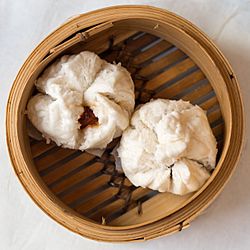Cha siu bao facts for kids
 |
|
| Alternative names | Char siu bao, chashaobao, manapua, keke pua'a, chao pao |
|---|---|
| Type | Dim sum |
| Place of origin | Southern [china] |
| Serving temperature | Hot |
| Main ingredients | Pork |
| Variations | Baked or steamed |
| 501.2 kcal (2098 kJ) | |
| Cha siu bao | |||||||||||||||||||||
|---|---|---|---|---|---|---|---|---|---|---|---|---|---|---|---|---|---|---|---|---|---|
| Simplified Chinese | 叉烧包 | ||||||||||||||||||||
| Traditional Chinese | 叉燒包 | ||||||||||||||||||||
| Jyutping | caa1siu1 baau1 | ||||||||||||||||||||
| Hanyu Pinyin | chāshāo bāo | ||||||||||||||||||||
| Literal meaning | "barbecued pork bun" | ||||||||||||||||||||
|
|||||||||||||||||||||
Char siu bao (simplified Chinese: 叉烧包; traditional Chinese: 叉燒包; pinyin: chāshāo bāo; Cantonese Yale: chāsīu bāau) is a delicious Cantonese bun filled with tasty barbecue-pork. It's a popular type of dim sum, which are small dishes often served with tea. You can find these yummy buns in many Chinese bakeries.
The name Char siu bao tells you what's inside. Char siu means "barbecue pork," and bao simply means "bun." So, it's a "barbecue pork bun"!
Contents
What is Char Siu Bao?
There are two main kinds of Char siu bao that people enjoy. The most common one is the traditional steamed version. It has a soft, fluffy white outside. This type is often called 蒸叉燒包 or just 叉燒包.
The other type is baked. This one has a golden-brown, shiny outside. It's usually called 叉燒餐包. Both kinds are super tasty, but they look a bit different!
How is it Made?
Even though Char siu bao looks like other steamed buns, its dough is special. It uses both yeast and baking powder to make it rise. This mix gives the bun a unique texture. It feels soft and fine, like a slightly dense bread.
Inside the bun, you'll find tender, sweet, slow-roasted pork. This char siu pork is cut into small pieces. Then, it's mixed with a yummy, syrupy sauce. This sauce often includes oyster sauce, hoisin sauce, sesame oil, rice vinegar, shaoxing wine (or dry sherry), soy sauce, sugar, and cornstarch.
Char Siu Bao Around the World
This delicious bun is loved in many places, and it has different names and slight variations depending on where you are!
Siopao in the Philippines
In the Philippines, the local version of this bun is called Siopao (simplified Chinese: 烧包; traditional Chinese: 燒包; Pe̍h-ōe-jī: sio-pau). Its name means "hot bun." It's the Filipino way of making the Cantonese steamed bun.
Manapua in Hawaii
When Chinese immigrants came to Hawaii to work on plantations, they brought this dim sum with them. In Hawaii, it's known as manapua. This name comes from the Hawaiian words mea ʻono puaʻa, which means "delicious pork thing."
Hawaiian manapua buns are usually bigger than the Chinese ones. They can be steamed or baked. In Hawaii, manapua sellers are very common and have become a symbol of the islands. The pork filling often has a dark pink color. This color comes from a tiny bit of saltpeter used to marinate the pork before it's slow-roasted.
Over time, manapua has come to mean any bun with this special dough that's filled with meat or even bean paste. You can find versions with hot dogs, curry chicken, or kalua pig. There's even a vegetarian version made with ube (purple yam). You can buy fresh or frozen manapua in bakeries, restaurants, and stores across Hawaii.
Chao Pao in French Polynesia
Bao buns are also popular in Tahiti, French Polynesia. There, they are called chao pao. Chinese people brought them to the islands in the mid-1800s. Even after all this time, the chao pao still tastes very much like the original. It's a local favorite and is often sold in small Chinese family stores as a breakfast item.
Xíu Páo in Vietnam
In Vietnam, this bun is called xíu páo. It came from Guangdong and Chaozhou, brought by a large Chinese community living in Hakka street in Nam Dinh, Vietnam. The ingredients for baking usually include flour, meat, eggs, lard, and special spices. To make them delicious, people marinate pork tenderloin with garlic, five-spice powder, oyster oil, and honey. Then, they bake it until it's golden and fragrant. The char siu meat is cut into small pieces and mixed with wood ear mushrooms, pork fat, and half a boiled chicken egg. The name "xíu páo" is thought to come from Cantonese or Hokkien words.
See also
In Spanish: Cha siu baau para niños


